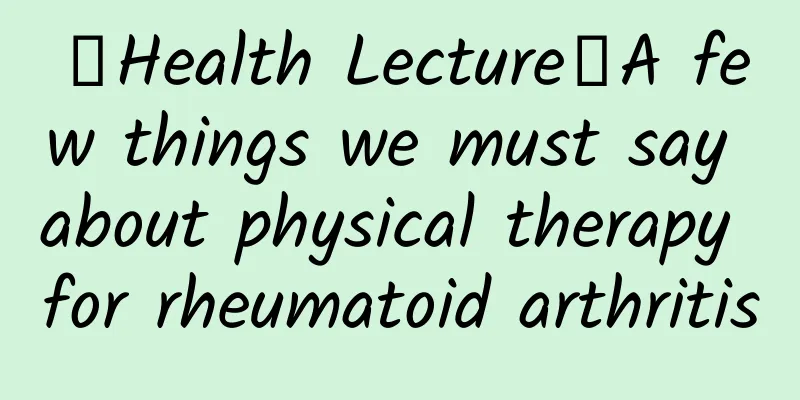【Health Lecture】A few things we must say about physical therapy for rheumatoid arthritis

|
In order to ensure the popularization effect of learning health knowledge in the 3rd China Elderly Health Knowledge Competition, the organizers have collected various health science articles suitable for elderly people to learn from various hospitals. We will share them through the "Health Lecture Hall" column. Today, Dr. Zhang Qi, Director of the First Sports Therapy Department of Beijing Boai Hospital, China Rehabilitation Research Center, brought us "A Few Things We Must Say About Rheumatoid Arthritis Physical Therapy". Elderly friends are welcome to learn. Do you have a friend who is like a "weather forecaster"? Whether it is the drizzling rain during the plum rain season or the wind and rain when the temperature drops sharply, their "forecast" is even more accurate than the weather forecast. This is certainly not a superpower, but they are likely to suffer from rheumatoid arthritis. Rheumatoid arthritis is a disease that affects the whole body and is characterized by joint pain and swelling. It is often symmetrically distributed, sometimes better and sometimes worse. Further development will lead to joint deformation and dysfunction, and finally form a systemic chronic disease. It is a systemic connective tissue disease. It is more common in women between the ages of 35 and 45, with a slow course and acute onset. It has two main causes. One is that the immune system produces an immune response under certain environmental conditions, leading to synovial proliferation, inflammatory cell proliferation, and cartilage degeneration. The other is caused by infection caused by Group A Streptococcus. Rheumatoid arthritis has many symptoms. In the early stages of the disease, there may be symptoms of low fever, fatigue, weight loss, and anemia. The typical symptoms are swelling and pain in multiple joints. The affected joints are the hands, wrists, knees, elbows, feet, shoulders, and hips. Most patients also begin to realize that they may have this disease because of swelling and dull pain in these joints. Another typical symptom is joint stiffness, which is particularly obvious when getting up in the morning, so it is also called "morning stiffness." In addition, there may be joint deformities, subcutaneous nodules in the joints, muscle atrophy, tendinitis, and tenosynovitis. How to determine if you have rheumatoid arthritis? According to the diagnostic criteria of the American College of Rheumatology, a diagnosis of rheumatoid arthritis requires 4 of the following 6 items: ① Morning stiffness for more than 1 hour, lasting for 6 weeks; ② Swelling or effusion in at least 3 joints, lasting for 6 weeks; ③ At least one of the wrist, metacarpophalangeal joints or proximal interphalangeal joints is swollen, lasting for 6 weeks; ④ Symmetrical swelling of joints on both sides of the body; ⑤ Rheumatoid factor is positive in blood tests; ⑥ X-ray examinations show bone erosion or osteoporosis changes. Nowadays, people's living standards are constantly improving, and everyone's requirements for quality of life are getting higher and higher. In the past, when people were diagnosed with rheumatoid arthritis, most of them only chose to take medication to relieve pain; with the continuous popularization of rehabilitation concepts in China, more and more rheumatoid arthritis patients choose physical therapy on the basis of drug treatment to help them improve their functions and improve their quality of life. So what is physical therapy? What problems can physical therapy help patients with rheumatoid arthritis solve? Physical therapy (PT) is a profession that combines prevention, treatment and improvement of functional disorders caused by diseases and injuries. It aims to maximize the patient's function and improve the patient's quality of life. It plays an important role in modern medicine. As the executor of physical therapy, physical therapists mainly focus on pain management, strengthening muscle strength, increasing joint mobility, improving cardiopulmonary function, improving mobility and participation, etc. For rheumatoid arthritis, physical therapy can control pain, expand the range of motion of limited joints, eliminate joint edema, increase muscle strength, improve motor function and improve the quality of daily life. In the acute stage, the main goal of physical therapy is to help patients relieve pain, correct joint deformities, and restore and improve physical strength. Physical therapists will advise patients at this stage to first ensure adequate bed rest. When symptoms are relieved and physical strength allows, bed gymnastics training can be performed. The movements of bed gymnastics training are simple and easy to understand, with the purpose of not causing pain or limiting joint mobility. For example, when lying in bed, slowly raise your hands from the side of the body to the top of your head, make a fist with five fingers and then open it, curl up your legs and then put them down, etc. Physical therapists will also help patients choose personalized orthopedic splints to fix deformed fingers or wrist joints, but it should be noted that it should not exceed 3 weeks in general to avoid further stiffness of the joints. When the condition is stable, the goal of physical therapy is to strengthen muscle strength, maintain normal range of joint motion and improve motor function. At this stage, physical therapists will develop different training programs according to the different performances of patients. For low muscle strength, muscle strengthening training will be selected to help patients improve muscle strength, such as asking patients to keep their elbows bent, with the angle between the upper and lower arms at 90°, and then keep their arms still, tighten their muscles for 6 seconds and then relax, repeating 10 times. If joint motion is limited, stretching training will be selected to help expand the range of joint motion, such as asking patients with limited shoulder joints to sit on a chair, and physical therapists will first help patients to perform shoulder rotation and flexion and extension movements, and then ask patients to actively complete the above movements without pain. In daily life, patients with rheumatoid arthritis can enhance their motor function by doing aerobic exercises such as walking, jogging, cycling, and swimming without pain and excessive fatigue. In addition, it is also very important for patients to eat a light diet, reduce unnecessary stress, and pay attention to keeping the diseased joints warm. About the Author Zhang Qi graduated from the Hong Kong Polytechnic University with a bachelor's and master's degree in physical therapy. His current titles are chief therapist, professor, and master's supervisor. He serves as the director of the first sports therapy department of Beijing Boai Hospital, China Rehabilitation Research Center, deputy director of the office of the National Autism Rehabilitation Research Center, and director of the PT teaching and research department of the Capital Medical University School of Rehabilitation Medicine. He is a member of the board of directors of the Beijing Rehabilitation Medicine Association, deputy director of the Children's Physical Therapy Committee of the Chinese Rehabilitation Medicine Association; deputy director of the Physical Therapy Professional University Alliance of the Chinese Rehabilitation Medicine Association; member of the Expert Advisory Committee on Rehabilitation and Relief of Disabled Children; member of the Department Affairs Committee of the Department of Rehabilitation Medicine of Capital Medical University; leader of the Children's Rehabilitation Group of the Science Popularization and Health Education Working Committee of the Chinese Medical Education Association; deputy leader of the Rehabilitation Therapy Group of the Children's Cerebral Palsy Rehabilitation Professional Committee of the China Disabled Persons Rehabilitation Association. Reviewer of "Chinese Journal of Rehabilitation Theory and Practice" and "The Journal of Physical Therapy Science". |
<<: A brief introduction to operating room nursing
>>: Nine common misunderstandings about diabetes prevention and treatment
Recommend
Do you really know the seriousness of cervical erosion?
Cervical erosion is the most common symptom of ce...
What is the problem with fried rice being sticky? What should I do if the fried rice is too sticky?
We all know that fried rice is a common delicacy....
What to do if you have coccyx pain during pregnancy
A woman's body will undergo many changes afte...
Can I have sex with a condom before having an IUD inserted?
The IUD can be said to be a very effective, safe ...
Causes of abdominal pain caused by increased leucorrhea
Increased vaginal discharge is itself an abnormal...
What are the effective treatments for vulvar leukoplakia?
Nowadays, many female friends suffer from vulvar ...
Best dietary therapy for anemia in pregnant women
I believe everyone must know the benefits of diet...
Xing Nianzeng: See through the disguise of urinary system tumors. It is low-key, so you have to be high-key!
In many people's impressions, urinary system ...
Symptoms of female ovarian chocolate cysts
Chocolate cyst is a common disease among women. I...
Low temperature in the morning and high temperature in the afternoon
Body temperature, weight, height, etc. change all...
The disadvantages of epidural delivery
Many people may not be fully aware of the disadva...
Can I take Guizhi Fuling Capsule during menstruation?
Many people may not have heard of Guizhi Fuling C...
What should I do if I have a small cyst on my cervix?
I believe everyone has heard of cervical cyst. In...
Six months pregnant, my stomach is always tight
Some women will experience abdominal tightness wh...
Can cancer be transmitted between husband and wife? Four types of cancer are likely to develop into "couple cancer", so be careful
Author: Zhang Xiufeng, deputy chief physician of ...









